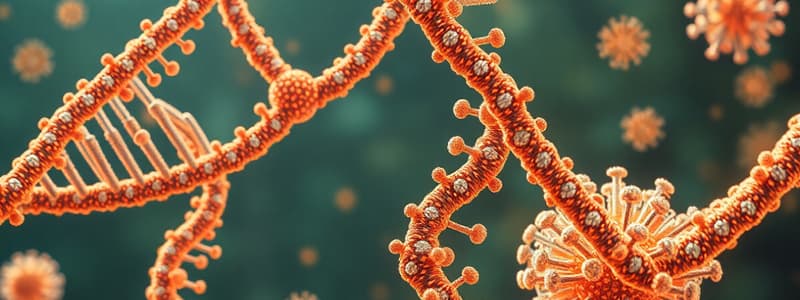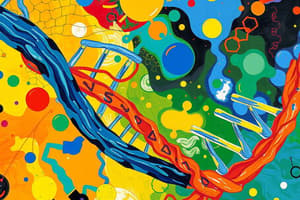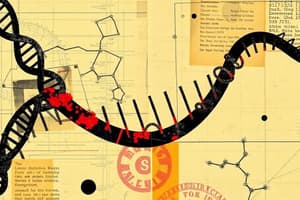Podcast
Questions and Answers
What is a major difference in the structure of DNA between prokaryotes and eukaryotes?
What is a major difference in the structure of DNA between prokaryotes and eukaryotes?
Prokaryotic DNA is circular, while eukaryotic DNA is linear.
How do the speeds of replisomes compare between prokaryotes and eukaryotes?
How do the speeds of replisomes compare between prokaryotes and eukaryotes?
Prokaryotic replisomes are fast, while eukaryotic replisomes are slower.
What is the purpose of telomeres in eukaryotic DNA replication?
What is the purpose of telomeres in eukaryotic DNA replication?
Telomeres protect the ends of linear chromosomes from losing genetic material during replication.
Identify the main DNA polymerases involved in prokaryotic replication and their roles.
Identify the main DNA polymerases involved in prokaryotic replication and their roles.
Signup and view all the answers
Explain the significance of having multiple origins of replication in eukaryotic cells.
Explain the significance of having multiple origins of replication in eukaryotic cells.
Signup and view all the answers
What role does topoisomerase play in prokaryotic DNA replication?
What role does topoisomerase play in prokaryotic DNA replication?
Signup and view all the answers
How does the location of replication differ between prokaryotic and eukaryotic cells?
How does the location of replication differ between prokaryotic and eukaryotic cells?
Signup and view all the answers
What is the impact of post-translational modifications on eukaryotic replication speed?
What is the impact of post-translational modifications on eukaryotic replication speed?
Signup and view all the answers
How does eukaryotic DNA replication differ from prokaryotic DNA replication?
How does eukaryotic DNA replication differ from prokaryotic DNA replication?
Signup and view all the answers
What is the role of RNA-dependent RNA polymerase in RNA viruses?
What is the role of RNA-dependent RNA polymerase in RNA viruses?
Signup and view all the answers
Describe how operons in prokaryotes compare to gene organization in eukaryotes.
Describe how operons in prokaryotes compare to gene organization in eukaryotes.
Signup and view all the answers
What are the consequences of a missense mutation within an open-reading frame?
What are the consequences of a missense mutation within an open-reading frame?
Signup and view all the answers
How do transcriptional repressors affect gene expression in bacteria?
How do transcriptional repressors affect gene expression in bacteria?
Signup and view all the answers
Explain the role of sigma factors in bacterial transcription.
Explain the role of sigma factors in bacterial transcription.
Signup and view all the answers
What is unique about retroviruses compared to RNA and DNA viruses regarding their replication?
What is unique about retroviruses compared to RNA and DNA viruses regarding their replication?
Signup and view all the answers
What distinguishes regulatory mutations from open-reading frame mutations?
What distinguishes regulatory mutations from open-reading frame mutations?
Signup and view all the answers
How do bacteria utilize quorum sensing to regulate gene expression?
How do bacteria utilize quorum sensing to regulate gene expression?
Signup and view all the answers
What role do transcriptional activators play in bacterial transcription?
What role do transcriptional activators play in bacterial transcription?
Signup and view all the answers
Reflect on the complexity of gene regulation in viruses, particularly with examples like HIV.
Reflect on the complexity of gene regulation in viruses, particularly with examples like HIV.
Signup and view all the answers
Why do RNA viruses exhibit higher mutation rates than DNA viruses?
Why do RNA viruses exhibit higher mutation rates than DNA viruses?
Signup and view all the answers
Describe the significance of enhancers and silencers in eukaryotic gene regulation.
Describe the significance of enhancers and silencers in eukaryotic gene regulation.
Signup and view all the answers
What are the primary functions of promoters in bacterial transcription?
What are the primary functions of promoters in bacterial transcription?
Signup and view all the answers
Study Notes
DNA Replication Differences
- Prokaryotic replication is fast, with a single origin of replication (oriC), while eukaryotic replication is slower, using multiple origins and dealing with nucleosomes.
- Prokaryotic chromosomes are circular, avoiding the end-replication problem. Eukaryotic chromosomes are linear, requiring telomeres.
- Topoisomerase is crucial for disentangling intertwined circular chromosomes in bacteria, while eukaryotes use telomeres.
- Prokaryotes employ a single Pol III enzyme for leading strand and two for lagging strand synthesis. Eukaryotes use Pol ε for leading and Pol δ for lagging synthesis.
- Prokaryotic replication happens in the cytoplasm, allowing simultaneous transcription and translation. Eukaryotic replication occurs within the nucleus, separate from most transcription.
Viral Genome Replication Mechanisms
- RNA viruses: Utilize RNA-dependent RNA polymerase, have high mutation rates due to lack of proofreading. Positive-sense single-stranded RNA (ssRNA) can directly serve as mRNA; negative-sense ssRNA must create a complimentary copy first.
- DNA viruses: Depend on host cell machinery for genome replication and mRNA transcription; dsDNA viruses use host RNA polymerase; ssDNA converts to dsDNA.
- Retroviruses: Employ reverse transcriptase to convert RNA into DNA, which then integrates into the host genome. HIV is a prominent retrovirus.
Gene Organization Differences: Prokaryotes vs. Eukaryotes
- Prokaryotes: Often organize genes into operons (e.g., lac operon). Operons are multiple genes sharing a single promoter and terminator, leading to polycistronic mRNA. Regulons coordinate multiple operons through a single regulator, like sigma factors.
- Eukaryotes: Primarily use monocistronic genes, meaning each gene is transcribed separately. They feature regulatory regions, such as enhancers and silencers, and their mRNA undergoes processing (splicing, capping, and polyadenylation).
Effects of Mutations
-
Open Reading Frame (ORF) mutations: Silent mutations have no effect; missense mutations change amino acids; nonsense mutations introduce premature stop codons; frameshift mutations disrupt the reading frame.
-
Regulatory mutations: Affect promoter, operator, enhancer/silencer regions. Promoter mutations affect RNA polymerase binding, hence transcription; operator mutations influence operon on/off states; enhancer/silencer changes alter gene activation/repression.
-
Key difference in types of mutations: ORF mutations change proteins, while regulatory mutations alter gene expression.
Bacterial Environmental Signaling
- Pseudomonas (GAC system): Detects signals, producing microRNAs that regulates transcription factors.
- Pseudomonas aeruginosa (Quorum Sensing): Uses acyl homoserine lactones (HSLs) to bind transcription factors, controlling virulence gene expression (e.g., exotoxin A and pyocyanin).
Viral Gene Expression Manipulation
- Viruses: Often commandeer host cell machinery to promote replication. HIV utilizes Tat to enhance viral RNA transcription and Rev to facilitate unspliced mRNA export from the nucleus for translation.
Bacterial Transcription Factors
- Promoters: DNA sequences that RNA polymerase binds to initiate transcription.
- RNA polymerase: Synthesizes RNA.
- Sigma factors: Direct RNA polymerase to promoters (key in stress conditions).
- Transcriptional activators: Increase transcription by enhancing RNA Polymerase binding.
- Transcriptional repressors: Decrease transcription by interfering with RNA polymerase binding.
- Example: Lac operon is controlled by LacI repressor and CAP activator depending on lactose presence/glucose availability.
Complexity in "Simple" Organisms
- Bacteria exhibit sophisticated strategies to respond to environmental changes, like quorum sensing and sigma factor-mediated stress response.
- Viruses manipulate host mechanisms to optimize their replication and gene expression.
Studying That Suits You
Use AI to generate personalized quizzes and flashcards to suit your learning preferences.
Description
This quiz explores the key differences in DNA replication between prokaryotes and eukaryotes, covering aspects like replication speed, chromosome structure, and enzyme roles. Additionally, it delves into RNA virus genome replication mechanisms, emphasizing the unique features of RNA-dependent RNA polymerase. Test your knowledge on these fundamental concepts in molecular biology.




